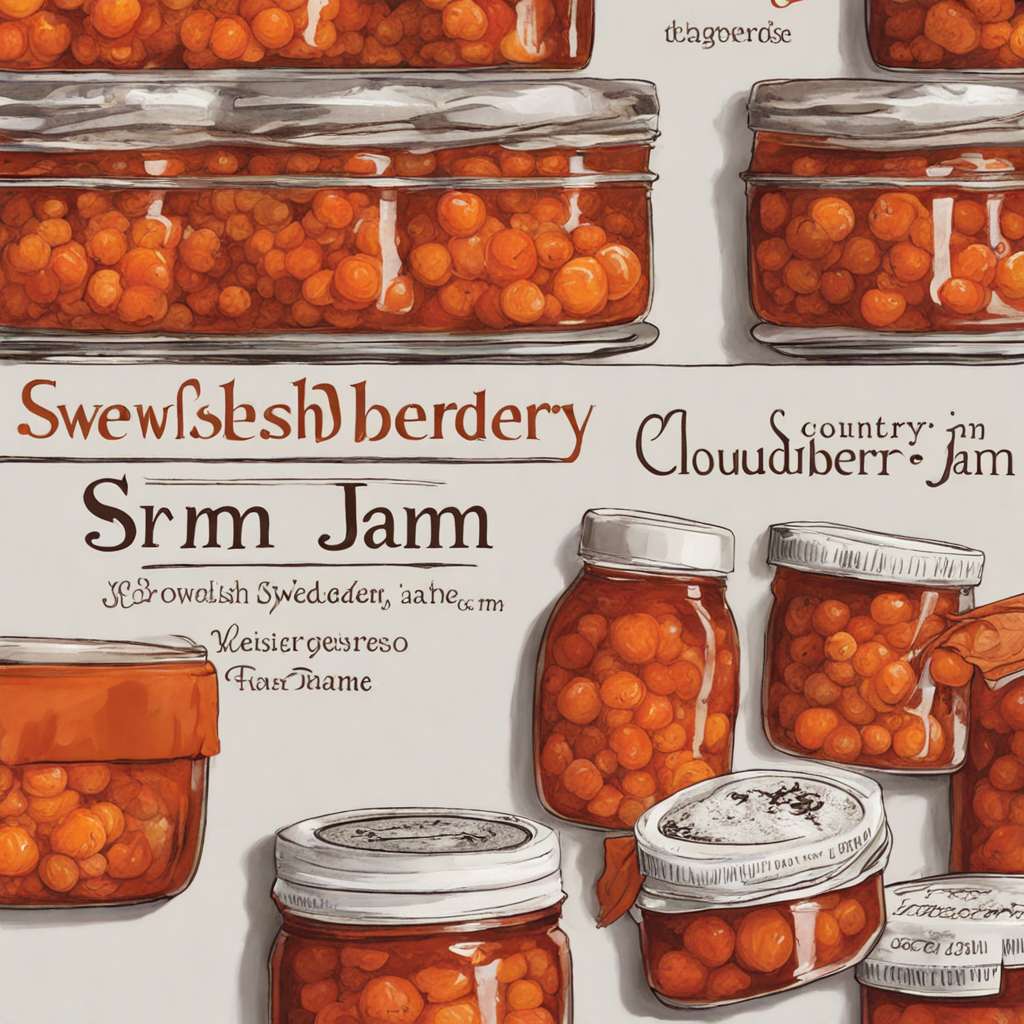Swedish Cloudberry Jam
Swedish Cloudberry Jam is a delightful and unique spread that encapsulates the essence of Sweden's wild and natural landscapes. Made from the fragrant orange-hued cloudberries, which grow in the northern parts of the country, this jam offers a taste experience that is both sweet and tart. The berries have a delicate, yet complex flavor profile, reminiscent of a cross between raspberries and apricots, with a subtle earthiness that comes from the unique growing conditions of the arctic climate. The jam is typically crafted with minimal ingredients, usually just the cloudberries, sugar, and sometimes a hint of lemon juice to enhance the natural flavors. The texture of Swedish Cloudberry Jam is smooth with a slight chunkiness, allowing you to savor the luscious fruit pieces as they burst in your mouth. The vibrant color and glossy sheen of the jam make it visually enticing, perfect for spreading on warm bread or pairing with cheese. It’s commonly enjoyed on traditional Swedish crispbread or alongside an assortment of pastries, making it a versatile addition to any meal or snack. The aromatic scent of the jam is also captivating, bringing forth memories of Swedish summer days spent foraging for these precious berries in the wild. This jam not only serves as a delicious treat but also carries with it a sense of cultural heritage and tradition. In Sweden, cloudberries are often considered a delicacy, and their seasonal availability makes them even more special. Whether you're enjoying it at breakfast, incorporating it into desserts like cheesecake or ice cream, or even using it as a glaze for meats, Swedish Cloudberry Jam offers a taste of the Scandinavian wilderness that is sure to enchant your palate and inspire culinary creativity.
How It Became This Dish
Hjortronsylt: The Sweet Essence of Swedish Wilderness Origins and Ingredients Hjortronsylt, or cloudberry jam, is a cherished delicacy in Sweden, deeply rooted in the country’s cultural and culinary heritage. The cloudberry (Rubus chamaemorus), a golden-hued berry that thrives in the wild, is found mainly in the northern regions of Scandinavia, including Sweden, Norway, and Finland. The berry grows in bogs and marshy areas and is known for its unique, sweet-tart flavor and delicate texture. The origins of hjortronsylt can be traced back to the indigenous Sámi people, who have inhabited the northern regions of Sweden for thousands of years. For the Sámi, cloudberries were not only a food source but also an important part of their traditional way of life. The berries were gathered during the short summer months and preserved for winter use, showcasing early techniques of food preservation. This practice laid the groundwork for the modern-day enjoyment of hjortronsylt, highlighting the connection between people and their environment. Cultural Significance Hjortronsylt is more than just a condiment in Sweden; it represents a sense of place and identity. The berry itself is emblematic of the Swedish wilderness, evoking images of pristine landscapes and the Nordic way of life. The act of foraging for cloudberries has become a cherished summer tradition for many Swedes, often involving family outings into the countryside. The experience of wandering through the bogs, searching for the elusive golden berries, fosters a deep appreciation for nature and the bounty it provides. In Swedish culture, hjortronsylt is often served as a topping for a variety of dishes. Its most common pairing is with traditional Swedish pancakes (pannkakor) or served alongside creamy vanilla ice cream. The sweet-tart flavor of the jam complements the rich, buttery notes of these dishes, creating a harmonious blend of textures and tastes. Additionally, hjortronsylt is frequently used in desserts, pastries, and even savory dishes, showcasing its versatility. The cloudberry has also earned a place in Swedish folklore and tradition. Known as "hjortron" in Swedish, the berry is often associated with myths and legends. Some tales tell of fairies who guard the cloudberry fields, and the harvest of these berries is sometimes accompanied by rituals intended to honor nature and ensure a bountiful harvest. This connection to folklore adds a layer of mystique to hjortronsylt, elevating it from a mere food item to a symbol of cultural heritage. Development Over Time The development of hjortronsylt over the centuries reflects broader changes in Swedish society and culinary practices. Historically, the preservation of cloudberries was a necessity, as the short growing season meant that foragers had to find ways to store this precious resource for the colder months. The traditional method of preserving cloudberries involved cooking them down with sugar, resulting in a sweet, spreadable jam that could last for months. This technique was passed down through generations, ensuring that the flavors of the wilderness could be enjoyed year-round. With industrialization and the rise of commercial food production in the 19th and 20th centuries, the production of hjortronsylt began to shift. As more people moved to urban areas, the demand for convenient, ready-made food products increased. This led to the commercialization of cloudberries, with larger producers entering the market. Today, hjortronsylt can be found in grocery stores across Sweden, often made with a combination of cloudberries, sugar, and sometimes pectin to enhance the jam's consistency. Despite this shift towards mass production, many artisanal producers continue to craft hjortronsylt using traditional methods, emphasizing the importance of high-quality, sustainably sourced ingredients. These small-scale producers often prioritize hand-harvested cloudberries, which not only supports local economies but also maintains the connection to the land that has characterized hjortronsylt for centuries. In recent years, the popularity of hjortronsylt has grown beyond Sweden's borders. As global interest in Scandinavian cuisine has surged, cloudberry products have caught the attention of food enthusiasts and chefs around the world. This newfound appreciation has led to innovative interpretations of hjortronsylt, with chefs incorporating it into contemporary dishes, cocktails, and gourmet desserts. Modern Trends and Sustainability The modern food movement has also brought an increased focus on sustainability and foraging, aligning with the traditional practices that have long surrounded hjortronsylt. As more people seek to reconnect with nature and understand where their food comes from, the act of foraging for cloudberries has gained popularity. This trend not only supports the local ecosystem but also promotes the idea of seasonal eating, encouraging a deeper appreciation for the flavors of each season. Moreover, the environmental challenges posed by climate change have heightened awareness of the delicate ecosystems where cloudberries grow. As the climate warms, the habitats suitable for cloudberries may shift, leading to concerns about the future of this iconic berry. Efforts to protect and preserve these natural habitats have gained momentum, ensuring that future generations can continue to enjoy hjortronsylt. Conclusion Hjortronsylt is a culinary gem of Sweden that encapsulates the spirit of the country’s natural heritage and cultural traditions. From its humble beginnings as a foraged berry to its status as a beloved condiment, the story of hjortronsylt is one of resilience, connection, and celebration of the land. As it continues to evolve and adapt in the modern culinary landscape, hjortronsylt remains a timeless reminder of the beauty and bounty of Sweden’s wilderness, inviting people to savor the flavors of the past while embracing the promise of the future.
You may like
Discover local flavors from Sweden







